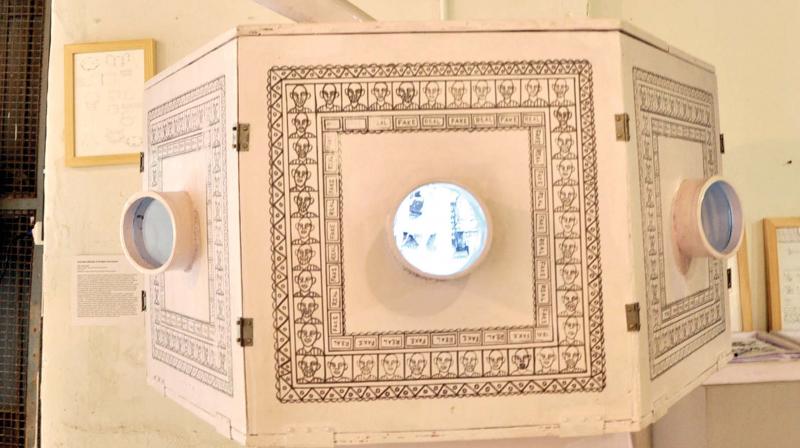Out of the classroom

At the Muhammed Ali Warehouse in Mattancherry, one of the Students’ Biennale venues, visitors have just begun to drop in. They are greeted by an array of artworks that narrate different stories — political, social, cultural and religious. The stories are being told through diverse mediums, both traditional and contemporary.
The first one is a video, Land of Water, by Jibin Abraham, Barnali Sutradhar, W. Dhanyabharati Devi and Monisha Roy. A site specific work on the fishing community of Irongmara in Assam, the video chronicles their daily life. Next to it is Animesh Mahata and Sudipta Karmarkar’s Fakeoscope that separates fake images that got viral on social media from their real images. Photoshopped images of Prime Minister Narendra Modi that went round are a prominent figure in this politically-charged work. A native of Odisha, Bhikhari Prasad’s hanging sculpture, in which sculptures that look like window facades are knitted together, is inspired from his village’s lifestyle.
Whereas J.U. Preeti, a student of Government College of Fine Arts, Chennai, has done an audio installation, Decibels, where women share struggles they face every day. N.Velan’s Scar, screen print on fabric, also talks women’s issues. The show goes on. In total, 113 individual and collaborative projects by 218 students from India and 28 students from partcipating SAARC countries (Bangladesh, Bhutan, Nepal, Pakistan and Sri Lanka) are on display at the seven venues that include Muhammed Ali Ware House, Kishore Traders, K.V.N. Arcade, Armaan Building, Coir Building, Temple Property and V.K.L. Property.
It was made possible by six curators – Sanchayan Ghosh, Shukla Sawant, K.P. Reji, Nishad M.P., Shruti Ramlingaiah and Krishnapriya C.P. “We created a format and put it on the website. Then, we divided the participants’ area into six zones. I was in charge of Eastern and North Eastern part, while Krishapriya checked Jammu and Kashmir and Chennai. Nishad looked after Kerala and Karnataka. The central Indian part was handled by Shukla. Reji chose students from the Gujarat-Maharashtra-Hyderabad belt. Shruthy took care of places like Odisha and Bihar,” says Sanchayan.
The curators visited art colleges to introduce the idea to students. It was not an easy task everywhere. Sanchayan says, at certain colleges in the North East, he had to do repeat visits to convince students and teachers. “Some institutions are not even initiated to the art of contemporary dialogue. That was a challenge.” In such cases, they brought eminent artists to colleges to talk to students about the possibilities of art. “We had to repeatedly visit those places,” he recalls. Though most of the colleges were willing to send their students, they were also worried about academics. “But then they realised that this practice can be a part of academics. That attitude was quite encouraging,” he says.
Students, too, agree with the fact that it is a once-in-a-lifetime opportunity, where they can understand contemporary art practices and experiment with different mediums. Saba Altaf, a final year BFA student from Kashmir, says, “It is a place where artists experiment with new ideas and mediums, which attracted me to here.” Her work Home made of cloth is linked to her memory. She lost her mother to a stray bullet at the age of 11. Since then, she has been searching for home. Saba feels that the day she lost her mother, she lost her home, too. She has done a tent-like structure using her mother’s old phiran. “That memory is still alive. It floats in my mind like you see it in the room,” says Saba. It is her second time at the biennale.
Anis Rasheed, who is also from the University of Kashmir, has done a video installation, which is a juxtaposition of the touristy Kashmir and the Kashmir that calls for freedom. “What the media and the tourism department promote is the beautiful Kashmir, which actually covers up the atrocities happening there. Hence, I decided to talk about two extremes,” he says. “I have never seen snow-capped mountains in my place. What I see is violence. I cannot praise beauty in the presence of violence,” he adds.
Not only Anis and Saba, almost all students from Kashmir depict the sad state of Kashmir in their works. “Because, that is what we experience there,” says Saba.
Myriads of thoughts will catch your attention as you move from one venue to another. There are works that talk about emotions, architecture, dance and music. Abijith E.A.’s untitled work in plywood and terracotta is a series of clay models that are stacked in neatly arranged small cubicles. “They are portraits of persons I have met,” says Abijith, a student of Raja Ravi Varma College of Fine Arts, Mavelikkara. In his opinion, the Students Biennale is a great platform for cultural exchange. “I could interact with students from other states and countries. I could learn about their art style. It is a give and take,” he says.
Anis concurs. “Our pedagogy contains only painting. Biennale was a breakthrough. I could experiment with different mediums after coming here.”
According to curator Sanchayan, the Students Biennale helps one attain professionalism. “They come out of their studio to work. They have to negotiate and find a place to exhibit their works. For that, they will have to be patient. That is a great lesson they learn from here.”
The Students Biennale runs parallel with the main Biennale.

